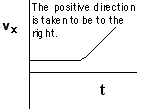A2L Item 057
- Description: Identify the correct velocity graph for ball rolling, first horizontally, then down an incline.
- Goal: Associate velocity graph with physical motion.
- Source: UMPERG
- Keywords: Velocity, Mechanics, Graphing
The question for students:
A soccer ball rolls across the road and down a hill as shown below.

Which of the following sketches of vx vs. t represents the horizontal velocity of the ball as a function of time?

Commentary for teachers:
Answer
 (5) None of the above. The ball crosses the road in a straight line at
a more-or-less constant speed (perhaps slowing down slightly) provided
that the road is in good condition and the rolling friction between the
ball and road is sufficiently small. As the ball rolls down the hill it
will speed up, and so there will be an acceleration in the direction of
motion, with a non zero component to the right. The following graph is
a reasonable representation of the horizontal velocity as a function of
time.
(5) None of the above. The ball crosses the road in a straight line at
a more-or-less constant speed (perhaps slowing down slightly) provided
that the road is in good condition and the rolling friction between the
ball and road is sufficiently small. As the ball rolls down the hill it
will speed up, and so there will be an acceleration in the direction of
motion, with a non zero component to the right. The following graph is
a reasonable representation of the horizontal velocity as a function of
time.
Background
This problem could challenge students in several areas: (1) Can students recognize how the velocity is changing? What criteria do they use? (2) Do students realize that as the ball moves down the hill it speeds up and the x-component of velocity increases? Students may associate the increase in velocity with the y-direction only. (3) Do students associate the graph with the terrain over which an object travels? The process of translation of a motion quantity to a graph can be very difficult for students. (4) Will students confuse motion quantities? When students analyze the graphs of velocity vs. time they may be interpreting the graphs in terms of position instead of velocity.
Questions to Reveal Student Reasoning
Is the velocity ever zero? Where does the ball speed up? …slow down? What is the direction of the velocity while the ball is on the sloped section? Does the velocity have a non-zero horizontal component?
Suggestions
Set up a demonstration with a horizontal surface and a ramp, both with the same net horizontal displacement. Roll a ball slowly across the horizontal surface and down the ramp. Ask students to judge which horizontal displacement took more time. Over what section (horizontal surface or ramp) is the velocity larger on average?